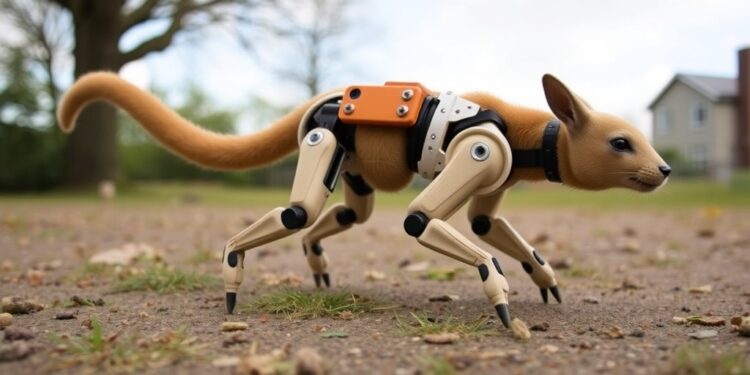In the quest to innovate and design advanced robotic systems capable of mid-air maneuverability, researchers from the University of Michigan and University of California San Diego have turned to the natural world for inspiration. Their recent study sheds light on the intricate biomechanics of mammalian tails, particularly how these appendages enable certain species to rotate their bodies in three-dimensional space. This exploration is rooted in the concept that evolution has equipped various animals with specialized tools and strategies for survival in unpredictable environments—a concept that synthetic designs can replicate for enhanced performance in robotics.
The core of this study revolves around the observation that while lizards exhibit strong, muscular tails that excel in rotating bodies along a single plane, the lighter, tendon-driven tails of mammals operate under a different paradigm. Talia Moore, an assistant professor of robotics at the University of Michigan, emphasizes the distinct functionality of mammalian tails, which not only allows them to form complex three-dimensional curves but also facilitates body rotation that may initially seem counterintuitive when compared to their more rigid counterparts. This realization has profound implications for robotics, particularly in minimizing weight while maximizing effectiveness through innovative tail design.
A decade ago, Moore had endeavored to study the tail dynamics of jerboas—desert rodents renowned for their remarkable two-legged hopping. Her initial exploratory efforts were thwarted by limitations in the existing kinematic equations that failed to account for the unique curvature and whipping motion of mammalian tails. At that time, she found it theoretically improbable that jerboas could generate the necessary tail movement to affect body rotation. However, this inquiry was rekindled when Xun Fu, a doctoral student in Moore’s group, set out to create a tail-equipped robot, prompting a revisitation of the tail dynamics question.
Utilizing sophisticated computer simulations, the research team sought to unravel the complexities of tail motion and its influence on body rotation. They meticulously analyzed various configurations of tail joints, aiming to determine whether increasing the number of segments and varying their lengths could enhance tail performance. By imposing challenges that required a simulated box-like body to reorient itself solely through tail motion in a zero-gravity environment, the researchers were able to gain insights into the mechanics governing tail-induced body maneuvers.
The findings revealed an optimal tail structure for inducing body rotation: a design characterized by numerous segments that began with a short bone, rapidly escalated to a longer bone, and then tapered off toward the tail’s tip. This discovery underscored a pattern of biomechanical efficiency that had been previously unrecognized in mammalian tail structures. Collaborating with counterparts at UC San Diego, the team also analyzed museum specimens to validate their simulation outcomes against the anatomical realities of various mammal species that exhibit mid-air reorientation abilities.
This joint effort provided compelling evidence that the evolutionary anatomy of mammalian tails often follows a similar crescendo-decrescendo pattern of bone lengths. The implications of these findings are substantial; they enhance our understanding of how these dynamic structures have adapted for optimal biomechanical performance in real-world scenarios. As noted by Ceri Weber, a postdoctoral researcher at UCSD, the evolutionary adaptations observed among tail skeletons lend credence to the notion that specific tail designs evolved to facilitate inertial maneuvering—an adaptive trait that could inspire future advancements in robotic mobility.
Perhaps one of the most exciting prospects of this research is its potential to transcend the study of tails. Moore and her team envision extending their simulation techniques beyond tails to analyze the biomechanics of limbs—arms, legs, and wings—thereby expanding the framework through which we can understand complex movements in both humans and animals. By examining how these appendages navigate three-dimensional spaces, researchers can glean insights that could ultimately lead to groundbreaking applications in robotics and biomechanics.
The study not only illustrates the intricacies of animal locomotion but also highlights the profound relationship between nature and technology. As robots continue to be integrated into various facets of life—from medical devices to exploration drones—understanding the biomechanical principles that govern natural movements will enhance robotic capabilities, making them more adaptable and efficient in dynamic environments.
The research was supported by a series of individual discretionary awards, signifying the significance of this work within the broader scientific community. Each funding source reflects a commitment to advancing knowledge in the fields of robotics, biology, and biomechanics, ensuring that such interdisciplinary efforts can move forward with necessary resources.
In summary, the team’s pioneering approach combining theory with simulation demonstrates the fruitful intersection of biological study and robotic design. As they continue to refine their models and validate their findings through empirical research, expectations are high for future innovations that could revolutionize how robots perceive and adapt to their environments. The ongoing dialogue between nature and technology will undoubtedly yield fascinating discoveries that bridge the worlds of biology and robotic engineering, showcasing how life itself provides lessons that can inform the mechanics of our most complex artificial creations.
The future of robotics stands to benefit immensely from the principles uncovered in this study, and researchers are just beginning to scratch the surface of what’s possible. The adaptability of living organisms, such as jerboas and other mammals, offers a blueprint for engineers striving to create machines that can mimic these natural efficiencies and perform tasks with unparalleled precision and effectiveness.
This remarkable journey into the biomechanics of mammalian tails not only enriches our understanding of animal agility and movement but also showcases the critical role of interdisciplinary research in sculpting the future landscape of both biological inquiry and technological advancement.
Subject of Research: Biomechanics of Mammalian Tails and Robotic Applications
Article Title: Jointed Tails Enhance Control of Three-Dimensional Body Rotation
News Publication Date: October 2023
Web References: Journal of The Royal Society Interface
References: DOI: 10.1098/rsif.2024.0355
Image Credits: N/A
Keywords
Biomechanics, Robotics, Tail Dynamics, Mammals, Engineering, Evolution, Simulation, 3D Rotation, Jerboas, Interdisciplinary Research.




